NASA, First Images from the James Webb Space Telescope & Image of The Day
James Webb Space Telescope
First Images from the James Webb Space Telescope
The dawn of a new era in astronomy has begun as the world gets its first look at the full capabilities of NASA’s James Webb Space Telescope, a partnership with ESA (European Space Agency) and CSA (Canadian Space Agency). The telescope’s first full-color images and spectroscopic data were released during a televised broadcast at 10:30 a.m. EDT (14:30 UTC) on Tuesday, July 12, 2022, from NASA’s Goddard Space Flight Center in Greenbelt, Maryland. These listed targets below represent the first wave of full-color scientific images and spectra the observatory has gathered, and the official beginning of Webb’s general science operations. They were selected by an international committee of representatives from NASA, ESA, CSA, and the Space Telescope Science Institute.
These first images from the world’s largest and most powerful space telescope demonstrate Webb at its full power, ready to begin its mission to unfold the infrared universe.
Press release: NASA Reveals Webb Telescope’s First Images of Unseen Universe
For more about Webb’s current status, visit the “Where Is Webb?” tracker.
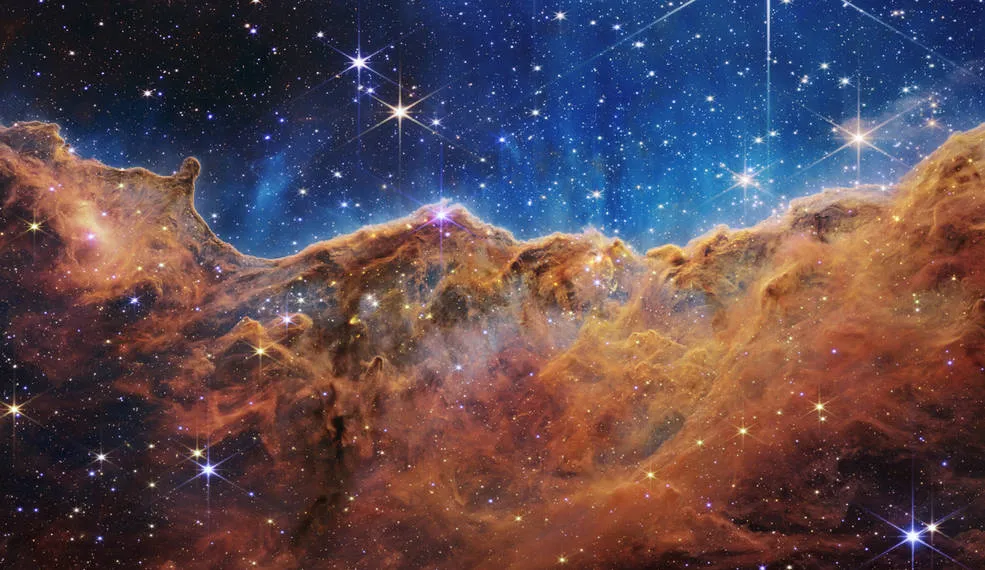 Credits: NASA, ESA, CSA, and STScI
Credits: NASA, ESA, CSA, and STScI
View larger version of this image
This landscape of “mountains” and “valleys” speckled with glittering stars is actually the edge of a nearby, young, star-forming region called NGC 3324 in the Carina Nebula. Captured in infrared light by NASA’s new James Webb Space Telescope, this image reveals for the first time previously invisible areas of star birth.
Called the Cosmic Cliffs, Webb’s seemingly three-dimensional picture looks like craggy mountains on a moonlit evening. In reality, it is the edge of the giant, gaseous cavity within NGC 3324, and the tallest “peaks” in this image are about 7 light-years high. The cavernous area has been carved from the nebula by the intense ultraviolet radiation and stellar winds from extremely massive, hot, young stars located in the center of the bubble, above the area shown in this image.
- Learn more about this image
- Download the full-resolution, uncompressed version and supporting visuals from the Space Telescope Science Institute
- View a Hubble Space Telescope image of Carina Nebula NGC 3324 (Hubblesite.org)
- En español
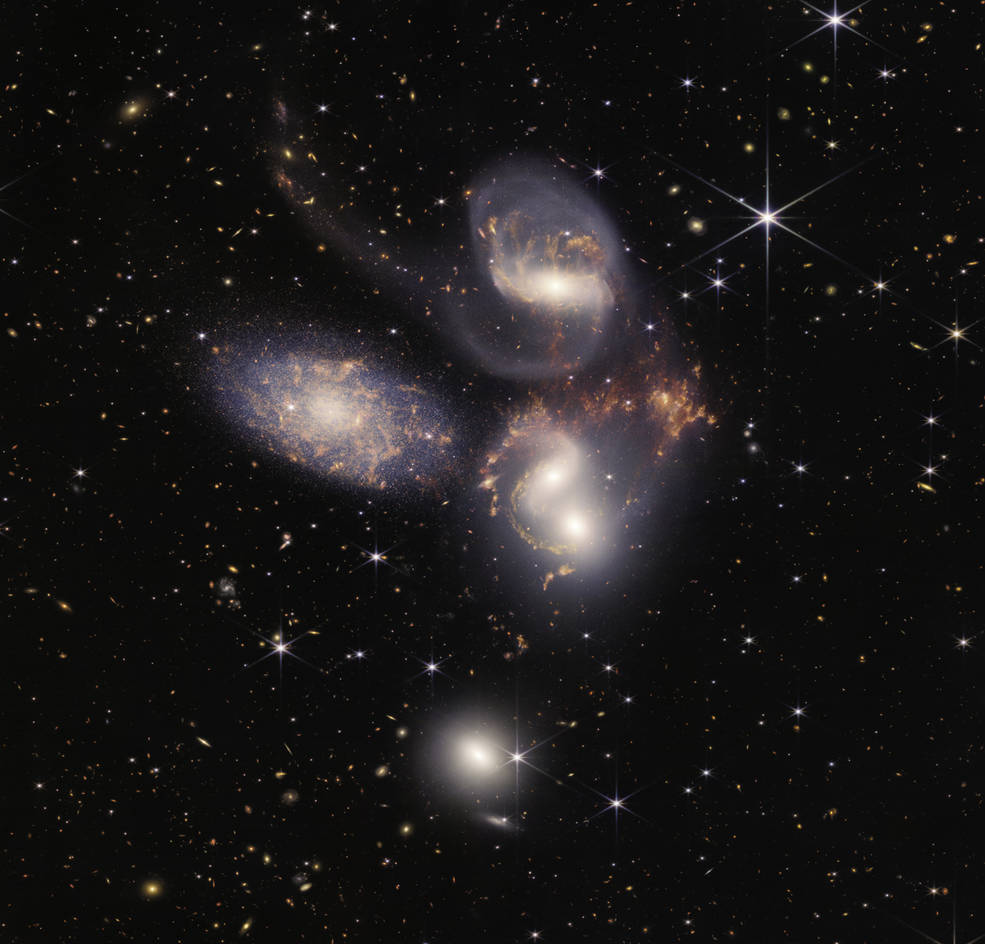 Credits: NASA, ESA, CSA, and STScI
Credits: NASA, ESA, CSA, and STScI
View larger version of this image
Stephan’s Quintet, a visual grouping of five galaxies, is best known for being prominently featured in the holiday classic film, “It’s a Wonderful Life.” Today, NASA’s James Webb Space Telescope reveals Stephan’s Quintet in a new light. This enormous mosaic is Webb’s largest image to date, covering about one-fifth of the Moon’s diameter. It contains over 150 million pixels and is constructed from almost 1,000 separate image files. The information from Webb provides new insights into how galactic interactions may have driven galaxy evolution in the early universe.
With its powerful, infrared vision and extremely high spatial resolution, Webb shows never-before-seen details in this galaxy group. Sparkling clusters of millions of young stars and starburst regions of fresh star birth grace the image. Sweeping tails of gas, dust and stars are being pulled from several of the galaxies due to gravitational interactions. Most dramatically, Webb captures huge shock waves as one of the galaxies, NGC 7318B, smashes through the cluster.
- Learn more about this image
- Download the full-resolution, uncompressed version and supporting visuals from the Space Telescope Science Institute
- View a Hubble Space Telescope image of Stephan’s Quintet (ESAHubble.org)
- En español
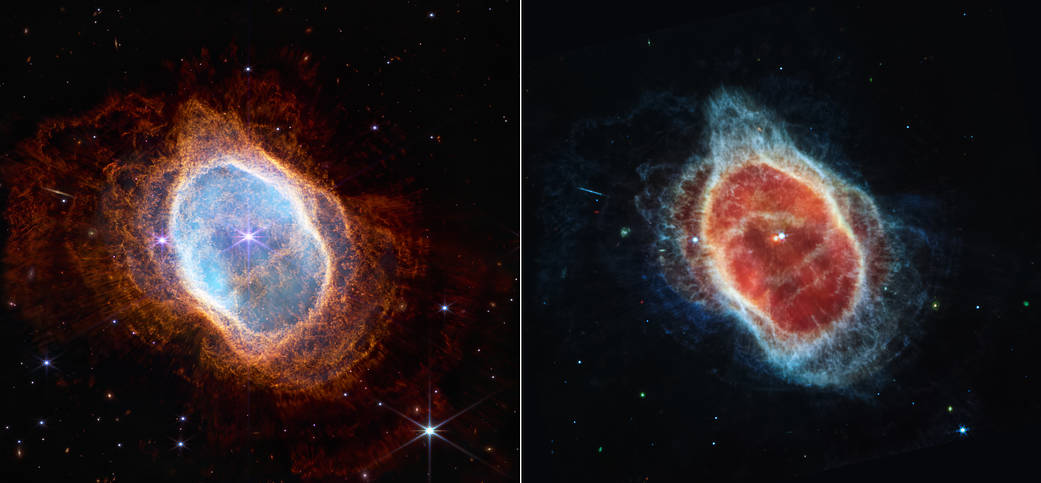
This scene was created by a white dwarf star – the remains of a star like our Sun after it shed its outer layers and stopped burning fuel though nuclear fusion. Those outer layers now form the ejected shells all along this view.
In the Near-Infrared Camera (NIRCam) image, the white dwarf appears to the lower left of the bright, central star, partially hidden by a diffraction spike. The same star appears – but brighter, larger, and redder – in the Mid-Infrared Instrument (MIRI) image. This white dwarf star is cloaked in thick layers of dust, which make it appear larger.
The brighter star in both images hasn’t yet shed its layers. It closely orbits the dimmer white dwarf, helping to distribute what it’s ejected.
Over thousands of years and before it became a white dwarf, the star periodically ejected mass – the visible shells of material. As if on repeat, it contracted, heated up – and then, unable to push out more material, pulsated. Stellar material was sent in all directions – like a rotating sprinkler – and provided the ingredients for this asymmetrical landscape.
Today, the white dwarf is heating up the gas in the inner regions – which appear blue at left and red at right. Both stars are lighting up the outer regions, shown in orange and blue, respectively.
The images look very different because NIRCam and MIRI collect different wavelengths of light. NIRCam observes near-infrared light, which is closer to the visible wavelengths our eyes detect. MIRI goes farther into the infrared, picking up mid-infrared wavelengths. The second star more clearly appears in the MIRI image, because this instrument can see the gleaming dust around it, bringing it more clearly into view.
The stars – and their layers of light – steal more attention in the NIRCam image, while dust pl
Credits: NASA, ESA, CSA, and STScI
View larger version of this image
Some stars save the best for last.
The dimmer star at the center of this scene has been sending out rings of gas and dust for thousands of years in all directions, and NASA’s James Webb Space Telescope has revealed for the first time that this star is cloaked in dust.
Two cameras aboard Webb captured the latest image of this planetary nebula, cataloged as NGC 3132, and known informally as the Southern Ring Nebula. It is approximately 2,500 light-years away.
Webb will allow astronomers to dig into many more specifics about planetary nebulae like this one – clouds of gas and dust expelled by dying stars. Understanding which molecules are present, and where they lie throughout the shells of gas and dust will help researchers refine their knowledge of these objects.
- Learn more about this image
- Download the full-resolution, uncompressed version and supporting visuals from the Space Telescope Science Institute
- View a Hubble Space Telescope image of the Southern Ring Nebula
- En español
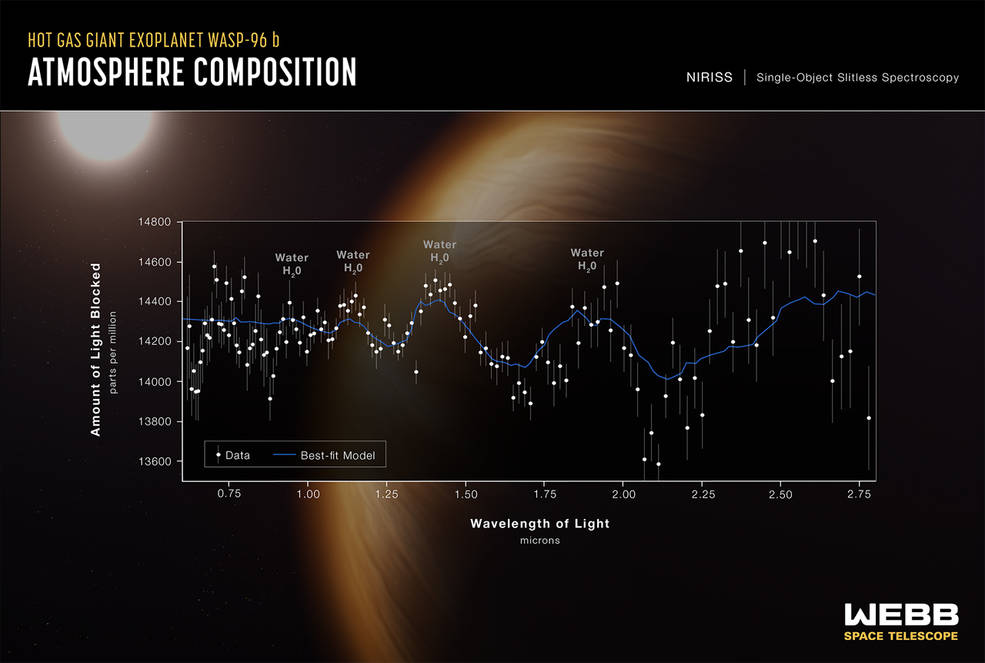 Credits: NASA, ESA, CSA, and STScI
Credits: NASA, ESA, CSA, and STScI
View larger version of this image
NASA’s James Webb Space Telescope has captured the distinct signature of water, along with evidence for clouds and haze, in the atmosphere surrounding a hot, puffy gas giant planet orbiting a distant Sun-like star.
The observation, which reveals the presence of specific gas molecules based on tiny decreases in the brightness of precise colors of light, is the most detailed of its kind to date, demonstrating Webb’s unprecedented ability to analyze atmospheres hundreds of light-years away.
While the Hubble Space Telescope has analyzed numerous exoplanet atmospheres over the past two decades, capturing the first clear detection of water in 2013, Webb’s immediate and more detailed observation marks a giant leap forward in the quest to characterize potentially habitable planets beyond Earth.
- Learn more about this image
- Download the full-resolution, uncompressed version and supporting visuals from the Space Telescope Science Institute
- En español
 Credits: NASA, ESA, CSA, and STScI
Credits: NASA, ESA, CSA, and STScI
View larger version of this image
NASA’s James Webb Space Telescope has produced the deepest and sharpest infrared image of the distant universe to date. Known as Webb’s First Deep Field, this image of galaxy cluster SMACS 0723 is overflowing with detail.
Thousands of galaxies – including the faintest objects ever observed in the infrared – have appeared in Webb’s view for the first time. This slice of the vast universe covers a patch of sky approximately the size of a grain of sand held at arm’s length by someone on the ground.
President Joe Biden unveiled this image during a White House event Monday, July 11.
- Learn more about this image
- Download the full-resolution, uncompressed version and supporting visuals from the Space Telescope Science Institute
- En español
For more information, please visit the following link:
https://www.nasa.gov/webbfirstimages
NASA Science Live: Webb’s First Full-Color Images Explained | Never Before Seen View of the Universe
Streamed live 9 hours ago, 7.13.2022 NASA
You’ve seen the pictures. What questions do you have? Our experts for NASA’s James Webb Space Telescope are ready to handle them in our NASA Science Live, starting at 3 p.m. ET (19:00 UTC) on Wednesday, July 13. Share your Qs with #UnfoldTheUniverse during our livestream. Have questions you want answered in Spanish? Tune in to a live Q&A at 1 p.m. EDT (17:00 UTC) on the NASA en español Facebook, Twitter and YouTube pages: Facebook: https://facebook.com/nasaes Twitter: https://twitter.com/nasa_es YouTube: https://youtube.com/nasaes Image credit: NASA Goddard/Chris Gunn
Highlights: First Images from the James Webb Space Telescope (Official NASA Video)
Jul 13, 2022 NASA
NASA revealed the first five full-color images and spectrographic data from the world’s most powerful space telescope, the James Webb Space Telescope, a partnership with ESA (European Space Agency), and CSA (Canadian Space Agency). The world got its first look at the full capabilities of the mission at a live event streamed from the agency’s Goddard Space Flight Center in Greenbelt, Maryland, on July 12, 2022. The event showcased these targets: – Carina Nebula: A landscape speckled with glittering stars and cosmic cliffs – Stephan’s Quintet: An enormous mosaic with a visual grouping of five galaxies – Southern Ring Nebula: A nebula with rings of gas and dust for thousands of years in all directions – WASP 96-b: A distinct signature of water in the atmosphere of an exoplanet orbiting a distant Sun-like star – SMACS 0723: The deepest and sharpest infrared image of the distant universe to date The full set of the telescope’s first full-color images and spectroscopic data are available at: https://nasa.gov/webbfirstimages Full-resolution images can be downloaded at: https://webbtelescope.org Credit: NASA Download Avail Link: https://images.nasa.gov/details-First…) Production Credit: Producer/Editor: Amy Leniarthtt
#NOVAPBS #JamesWebbSpaceTelescope #JWST
Ultimate Space Telescope | Full Documentary | NOVA | PBS 53:35
Premiered 102 minutes ago, 7.13.2022 NOVA PBS Official
Discover how NASA engineers built and launched the most ambitious telescope of all time. Official Website: https://www.pbs.org/nova/ | #NOVAPBS How did NASA engineers build and launch the most ambitious telescope of all time? Follow the dramatic story of the James Webb Space Telescope—the most complex machine ever launched into space. If it works, scientists believe that this new eye on the universe will peer deeper back in time and space than ever before to the birth of galaxies, and may even be able to “sniff” the atmospheres of exoplanets as we search for signs of life beyond Earth. But getting it to work is no easy task. The telescope is far bigger than its predecessor, the famous Hubble Space Telescope, and it needs to make its observations a million miles away from Earth—so there will be no chance to go out and fix it. That means there’s no room for error; the most ambitious telescope ever built needs to work perfectly. Meet the engineers making it happen and join them on their high stakes journey to uncover new secrets of the universe. This program is made possible by viewers like you. Support your local PBS station: https://www.pbs.org/donate Enjoy full episodes of your favorite PBS shows anytime, anywhere with the free PBS Video App: https://to.pbs.org/2QbtzhR FOLLOW US: NOVA YouTube: https://www.youtube.com/novaonline Facebook: https://www.facebook.com/NOVApbs Twitter: https://twitter.com/novapbs Instagram: https://www.instagram.com/novapbs/ TikTok: https://www.tiktok.com/@novapbs PBS Facebook: https://www.facebook.com/PBS/ Twitter: https://twitter.com/PBS/ Instagram: https://www.instagram.com/PBS/ TikTok: https://www.tiktok.com/@pbs Shop: https://shop.pbs.org/ #JamesWebbSpaceTelescope #JWST #Telescope #NASA #Space #SolarSystem #Universe
Webb Instrument Overview
An overview of the instruments onboard the Webb Telescope: the Near-Infrared Camera (NIRCam), Near-Infrared Spectrograph (NIRSpec), Mid-Infrared Instrument (MIRI), and the Fine Guidance Sensor/Near-Infrared Imager and Slitless Spectrograph. Learn how each instrument will help Webb unfold the universe. Credit: NASA’s Goddard Space Flight Center Michael McClare (KBRwyle): Lead Producer Michael Starobin (KBRwyle): Producer Sophia Roberts (AIMM): Producer Jonathan North (KBRwyle): Animator Adriana Manrique Gutierrez (KBRwyle): Animator Chris Meaney (KBRwyle): Animator Michael McClare (KBRwyle): Lead Videographer Michael McClare (KBRwyle): Lead Editor Rich Melnick (KBRwyle): Editor Sophia Roberts (AIMM): Lead Host Sophia Roberts (AIMM): Lead Narrator Download this video at: https://svs.gsfc.nasa.gov/14136
Webb Instrument Overview
James Webb Space Telescope (JWST)
An overview of the instruments onboard the Webb Telescope: the Near-Infrared Camera (NIRCam), Near-Infrared Spectrograph (NIRSpec), Mid-Infrared Instrument (MIRI), and the Fine Guidance Sensor/Near-Infrared Imager and Slitless Spectrograph. Learn how each instrument will help Webb unfold the universe. Credit: NASA’s Goddard Space Flight Center Michael McClare (KBRwyle): Lead Producer Michael Starobin (KBRwyle): Producer Sophia Roberts (AIMM): Producer Jonathan North (KBRwyle): Animator Adriana Manrique Gutierrez (KBRwyle): Animator Chris Meaney (KBRwyle): Animator Michael McClare (KBRwyle): Lead Videographer Michael McClare (KBRwyle): Lead Editor Rich Melnick (KBRwyle): Editor Sophia Roberts (AIMM): Lead Host Sophia Roberts (AIMM): Lead Narrator Download this video at: https://svs.gsfc.nasa.gov/14136
WATCH LIVE: Stunning new images from James Webb Space Telescope offer fuller picture of our universe
Streamed live 17 hours ago PBS NewsHour
Stream your PBS favorites with the PBS app: https://to.pbs.org/2Jb8twG Find more from PBS NewsHour at https://www.pbs.org/newshour Subscribe to our YouTube channel: https://bit.ly/2HfsCD6 Follow us: TikTok: https://www.tiktok.com/@pbsnews Twitter: http://www.twitter.com/newshour Instagram: http://www.instagram.com/newshour Facebook: http://www.pbs.org/newshour Subscribe: PBS NewsHour podcasts: https://www.pbs.org/newshour/podcasts Newsletters: https://www.pbs.org/newshour/subscribe
Seeing The Universe Like We’ve Never Seen It Before 39:00
Jul 12, 2022 Bloomberg Quicktake: Originals
Now that the James Webb Space Telescope has released its first images, it’s time for the science programs to begin. We meet 5 scientists who will be using the telescope during its first cycle of operations looking at the earliest galaxies, red giant stars in the disc of Andromeda, star forming regions in the MIlky Way and nearby galaxies, the Trappist-1 exoplanet system, and mysterious icy bodies beyond the orbit of Neptune. #JamesWebb #NASA #Space ——– Like this video? Subscribe: http://www.youtube.com/Bloomberg?sub_… Become a Quicktake Member for exclusive perks: http://www.youtube.com/bloomberg/join Subscribe to Quicktake Explained: https://bit.ly/3iERrup QuickTake Originals is Bloomberg’s official premium video channel. We bring you insights and analysis from business, science, and technology experts who are shaping our future. We’re home to Hello World, Giant Leap, Storylines, and the series powering CityLab, Bloomberg Businessweek, Bloomberg Green, and much more. Subscribe for business news, but not as you’ve known it: exclusive interviews, fascinating profiles, data-driven analysis, and the latest in tech innovation from around the world. Visit our partner channel QuickTake News for breaking global news and insight in an instant. 0:00 – A Giant Leap for Science 1:59 – First full color, science quality images of JWST 8:11 – COSMOS-Web: mapping the earliest structures of the Universe 14:11 – Unearthing the fossilised Andromeda Galaxy 21:49 – Star formation in the Milky Way, Large Magellanic Cloud and Small Magellanic Cloud 26:56 – Trappist-1: checking atmosphere of exoplanet system with multiple earth-like planets in the habitable zone 31:27 – TransNeptunian objects: discovering the composition of icy bodies beyond Neptune
Aug 1, 2022
NASA Pays Tribute to Nichelle Nichols
 NASA celebrates the life of Nichelle Nichols, Star Trek actor, trailblazer, and role model, who symbolized to so many what was possible. She partnered with us to recruit some of the first women and minority astronauts, and inspired generations to reach for the stars.
NASA celebrates the life of Nichelle Nichols, Star Trek actor, trailblazer, and role model, who symbolized to so many what was possible. She partnered with us to recruit some of the first women and minority astronauts, and inspired generations to reach for the stars.
In this photo from February 2012, Nichols was a featured guest speaker in the Building 8 auditorium at NASA’s Goddard Space Flight Center in Greenbelt, Md. at a special event commemorating of the life and legacy of Dr. Martin Luther King, Jr.
Read more: Nichelle Nichols Helped NASA Break Boundaries on Earth and in Space
Image credit: NASA/Goddard Space Flight Center/Pat Izzo
Last Updated: Aug 1, 2022
Editor: Michael Bock
Tags: Image of the Day
https://www.nasa.gov/image-feature/nasa-pays-tribute-to-nichelle-nichols
Jul 29, 2022
Zeta Ophiuchi: A Star With a Complicated Past
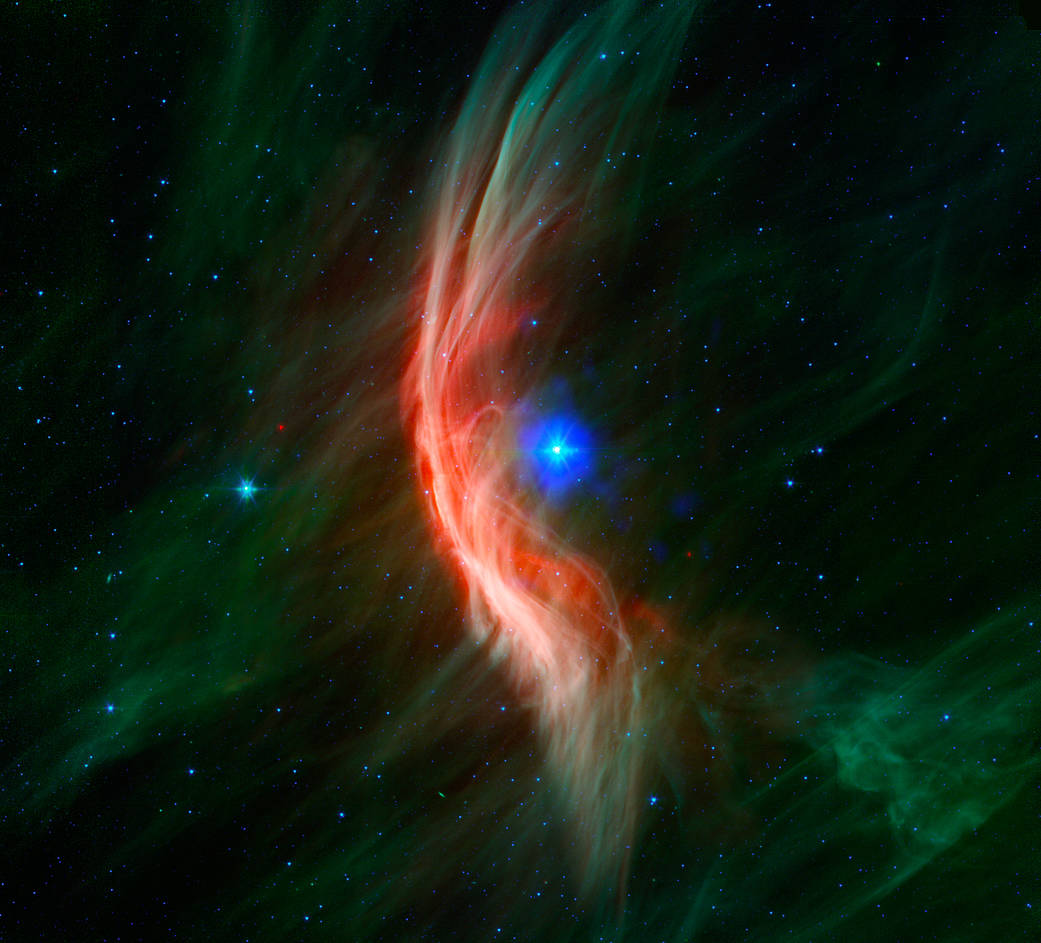
Zeta Ophiuchi is a young, large and hot star located around 370 light-years away. It dwarfs our own sun in many ways — it is about six times hotter, eight times wider, 20 times more massive, and about 80,000 times as bright. Even at its great distance, it would be one of the brightest stars in the sky were it not largely obscured by foreground dust clouds.
This massive star is travelling at a snappy pace of about 54,000 mph (24 kilometers per second), fast enough to break the sound barrier in the surrounding interstellar material. Because of this motion, it creates a spectacular bow shock ahead of its direction of travel (to the left). The structure is analogous to the ripples that precede the bow of a ship as it moves through the water, or the sonic boom of an airplane hitting supersonic speeds.
The fine filaments of dust surrounding the star glow primarily at shorter infrared wavelengths, rendered here in green. The area of the shock pops out dramatically at longer infrared wavelengths, creating the red highlights.
A bright bow shock like this would normally be seen in visible light as well, but because it is hidden behind a curtain of dust, only the longer infrared wavelengths of light seen by Spitzer can reach us.
Bow shocks are commonly seen when two different regions of gas and dust slam into one another. Zeta Ophiuchi, like other massive stars, generates a strong wind of hot gas particles flowing out from its surface. This expanding wind collides with the tenuous clouds of interstellar gas and dust about half a light-year away from the star, which is almost 800 times the distance from the sun to
Zeta Ophiuchi is a star with a complicated past, having likely been ejected from its birthplace by a powerful stellar explosion. A new look by NASA’s Chandra X-ray Observatory helps tell more of the story of this runaway star.
Located about 440 light-years from Earth, Zeta Ophiuchi is a hot star that is 20 times more massive than the Sun. Previous observations have provided evidence that Zeta Ophiuchi was once in close orbit with another star, before being ejected at about 100,000 miles per hour when this companion was destroyed in a supernova explosion over a million years ago. Previously released infrared data from NASA’s now-retired Spitzer Space Telescope, seen in this new composite image, reveals a spectacular shock wave (red and green) that was formed by matter blowing away from the star’s surface and slamming into gas in its path. Data from Chandra shows a bubble of X-ray emission (blue) located around the star, produced by gas that has been heated by the effects of the shock wave to tens of millions of degrees.
Read more: Embracing a Rejected Star
Image credit: X-ray: NASA/CXC/Dublin Inst. Advanced Studies/S. Green et al.; Infrared: NASA/JPL/Spitzer
Last Updated: Jul 29, 2022
Editor: Michael Bock
Tags: Chandra X-Ray Observatory, Image of the Day
https://www.nasa.gov/image-feature/zeta-ophiuchi-a-star-with-a-complicated-past
Jul 28, 2022
Vortices Near Jupiter’s North Pole
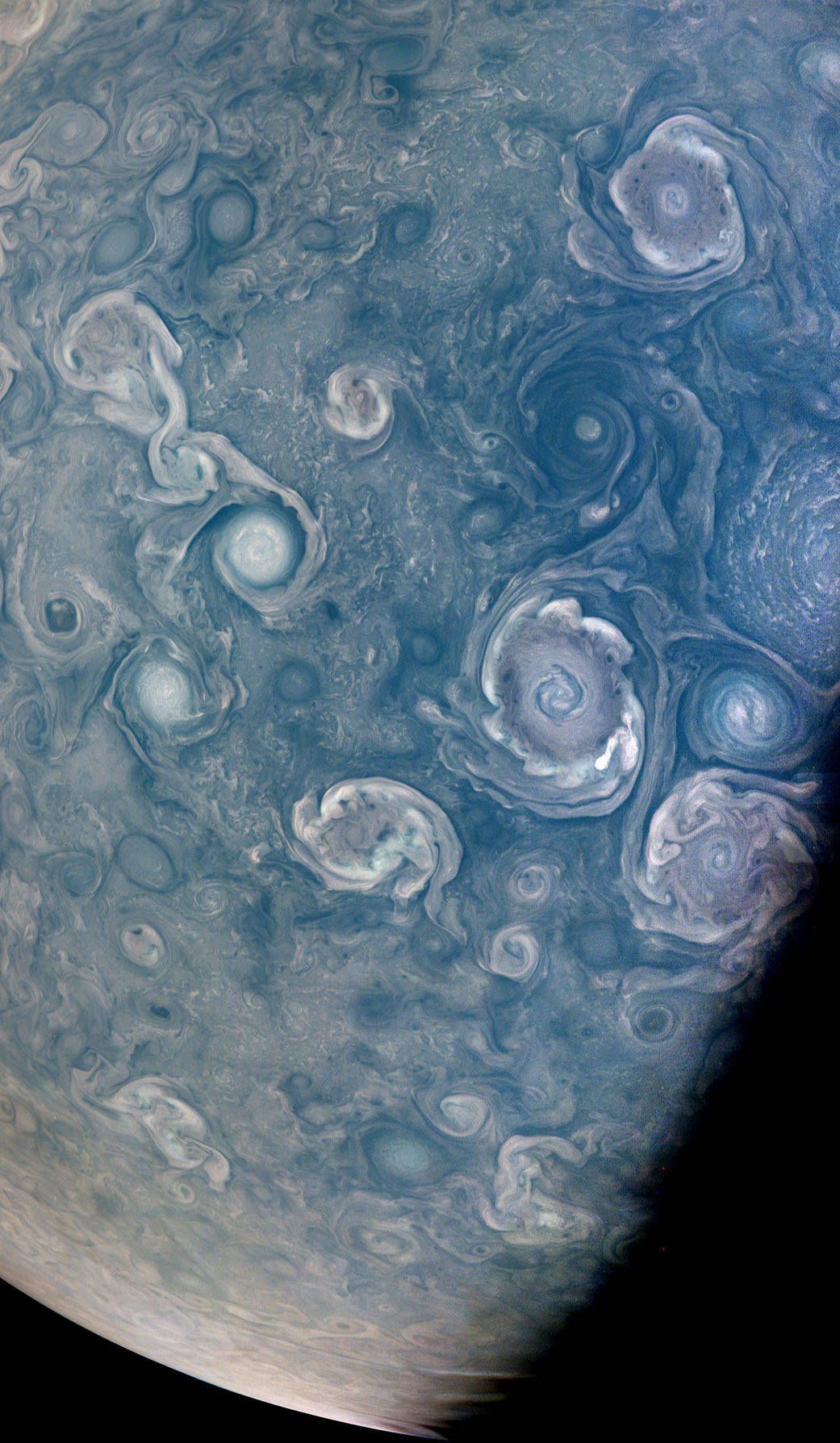 As NASA’s Juno mission completed its 43rd close flyby of Jupiter on July 5, 2022, its JunoCam instrument captured this striking view of vortices — hurricane-like spiral wind patterns — near the planet’s north pole.
As NASA’s Juno mission completed its 43rd close flyby of Jupiter on July 5, 2022, its JunoCam instrument captured this striking view of vortices — hurricane-like spiral wind patterns — near the planet’s north pole.
These powerful storms can be over 30 miles (50 kilometers) in height and hundreds of miles across. Figuring out how they form is key to understanding Jupiter’s atmosphere, as well as the fluid dynamics and cloud chemistry that create the planet’s other atmospheric features. A NASA citizen science project, Jovian Vortex Hunter, seeks help from volunteer members of the public to spot and help categorize vortices and other atmospheric phenomena visible in JunoCam photos of Jupiter. As of July 2022, 2,404 volunteers had made 376,725 classifications using the Jovian Vortex Hunter project web site at https://www.zooniverse.org/projects/ramanakumars/jovian-vortex-hunter.
Learn more
NASA’s Juno Mission Spies Vortices Near Jupiter’s North Pole
Image data: NASA/JPL-Caltech/SwRI/MSSS
Image processing by Brian Swift © CC BY
Last Updated: Jul 28, 2022
Editor: Michael Bock
Tags: Image of the Day, Juno, Jupiter
https://www.nasa.gov/image-feature/vortices-near-jupiter-s-north-pole
Jul 27, 2022
Preparing for the Next Generation of Flight

1011 Lockheed Way, Palmdale, Ca. 93599
Event: Forebody and Nose – Windtunnel Testing
Date: 2/10/2022
Additional Info:
Before NASA’s quiet supersonic X-59 aircraft takes to the skies, plenty of testing happens to ensure a safe first flight. One part of this safety check is to analyze data collected for the X-59’s flight control system through low-speed wind tunnel tests.
The X-59 is central to NASA’s Quesst mission to expand supersonic flight and provide regulators with data to help change existing national and international aviation rules that ban commercial supersonic flight over land. The aircraft is designed to produce a gentle thump instead of a sonic boom.
Recently, Lockheed Martin’s Skunk Works facility in Palmdale, California, completed low-speed wind tunnel tests of a scale model of the X-59’s forebody. The tests provided measurements of how wind flows around the aircraft nose and confirmed computer predictions made using computational fluid dynamics, or CFD, software tools. The data will be fed into the aircraft flight control system and will allow the pilot to know the altitude, speed and angle that the aircraft is flying at in the sky.
In this image, a technician works on the X-59 model during testing in the low-speed wind tunnel, in February 2022.
Learn more
Low-Speed Wind Tunnel Test Provides Important Data
Image Credit: Lockheed Martin
Last Updated: Jul 27, 2022
Editor: Yvette Smith
Tags: Aeronautics, Image of the Day, Quesst
https://www.nasa.gov/image-feature/preparing-for-the-next-generation-of-flight
Jul 26, 2022
Heading into (Orbital) Sunrise

The Sun’s rays begin to illuminate the Earth’s atmosphere as the International Space Station flew into an orbital sunrise 261 miles above Texas, as seen in this image taken by astronaut Bob Hines.
The crew doesn’t just snap pretty pictures; the research aboard the station benefits humanity in numerous ways. This week, the 11th annual International Space Station Research and Development Conference runs through Thursday, July 28, 2022, in Washington. The full conference agenda is available online.
NASA will provide live coverage of select panels from the conference on NASA Television, the NASA app, and the agency’s website.
The event coincides with the publication of the 2022 edition of the International Space Station Benefits for Humanity, highlighting the advances in scientific knowledge on Earth, and in space, physical, and biological sciences, aboard the microgravity laboratory for the benefits of people living on our home planet.
Learn more
15 Ways the International Space Station Benefits Humanity Back on Earth
Image Credit: NASA
Last Updated: Jul 26, 2022
Editor: Yvette Smith
Tags: Benefits to You, Humans in Space, Image of the Day
https://www.nasa.gov/image-feature/heading-into-orbital-sunrise
Jul 25, 2022
Blue Ripples on a Red Planet
 Though Mars is the Red Planet, false-color images can help us learn about its weather and geology. This image shows a variety of wind-related features on the Red Planet near the center of Gamboa Crater. Larger sand dunes form sinuous crests and individual domes.
Though Mars is the Red Planet, false-color images can help us learn about its weather and geology. This image shows a variety of wind-related features on the Red Planet near the center of Gamboa Crater. Larger sand dunes form sinuous crests and individual domes.
There are tiny ripples on the tops of the dunes, only several feet from crest-to-crest. These merge into larger mega-ripples about 30 feet apart that radiate outward from the dunes. The larger, brighter formations that are roughly parallel are called “Transverse Aeolian Ridges” (TAR). These TAR are covered with very coarse sand.
The mega-ripples appear blue-green on one side of an enhanced color cutout while the TAR appear brighter blue on the other. This could be because the TAR are actively moving under the force of the wind, clearing away darker dust and making them brighter. All of these different features can indicate which way the wind was blowing when they formed. Being able to study such variety so close together allows us to see their relationships and compare and contrast features to examine what they are made of and how they formed.
Image Credit: NASA/JPL-Caltech/University of Arizona
Last Updated: Jul 25, 2022
Editor: Yvette Smith
Tags: Image of the Day, Mars, Mars Reconnaissance Orbiter (MRO)
https://www.nasa.gov/image-feature/blue-ripples-on-a-red-planet
Jul 22, 2022
50 Years of Landsat
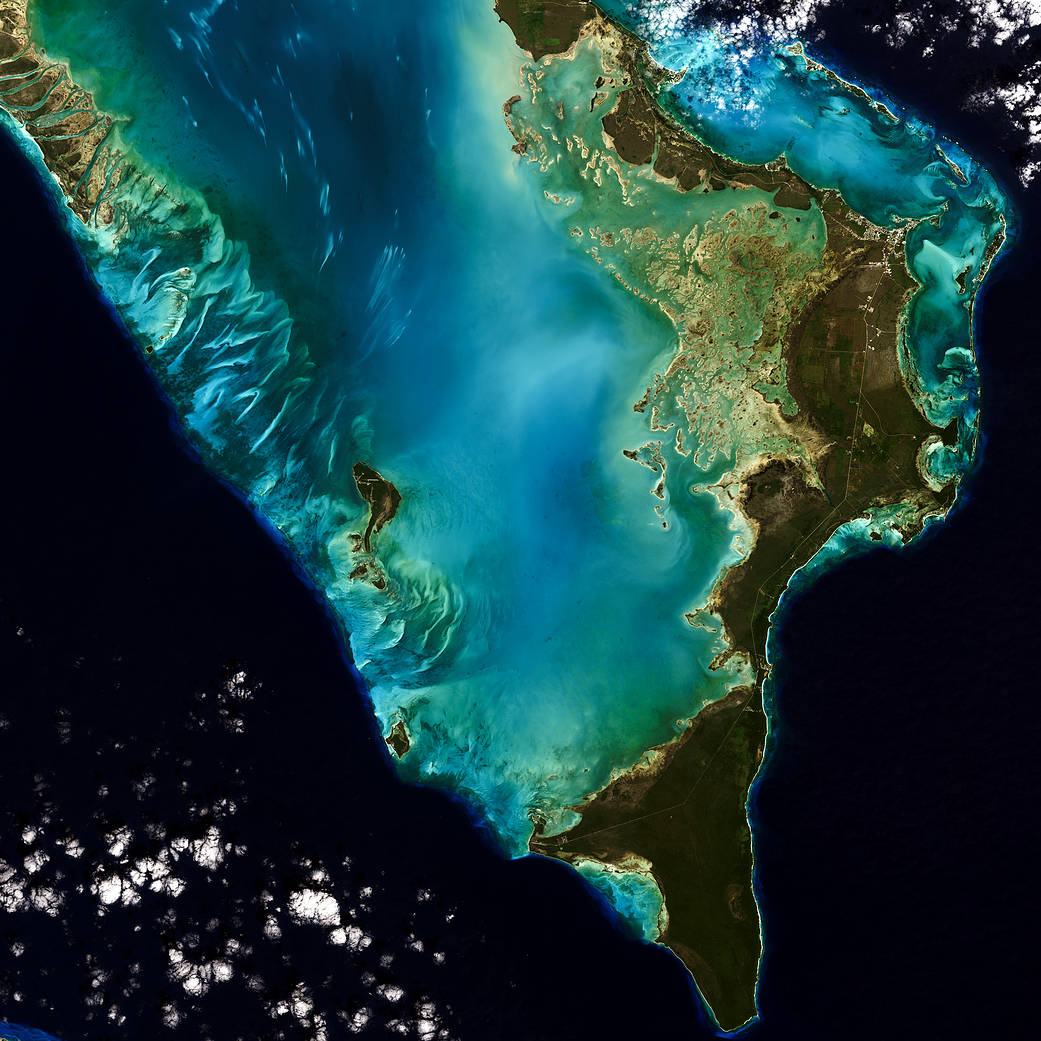 We’re celebrating 50 years of the Landsat satellite, the first of which launched on July 23, 1972. The latest in the series, Landsat 9, launched in September 2021.
We’re celebrating 50 years of the Landsat satellite, the first of which launched on July 23, 1972. The latest in the series, Landsat 9, launched in September 2021.
Landsat shows us Earth from space. For 50 years, the mission has collected data on the forests, farms, urban areas and freshwater of our home planet, generating the longest continuous record of its kind. Decision makers from across the globe use freely available Landsat data to better understand environmental change, manage agricultural practices, allocate scarce water resources, respond to natural disasters and more.
This natural color image of Eleuthera Island, the Bahamas, was taken by Landsat 9 on January 18, 2022. Between Landsat 8 and Landsat 9, the Landsat program delivers complete coverage of the Earth’s surface every eight days.
Image Credit: Michelle Bouchard using Landsat data from USGS
Last Updated: Jul 22, 2022
Editor: Yvette Smith
Tags: Earth, Image of the Day, Landsat
https://www.nasa.gov/image-feature/50-years-of-landsat
Jul 21, 2022
It’s CERTAIN
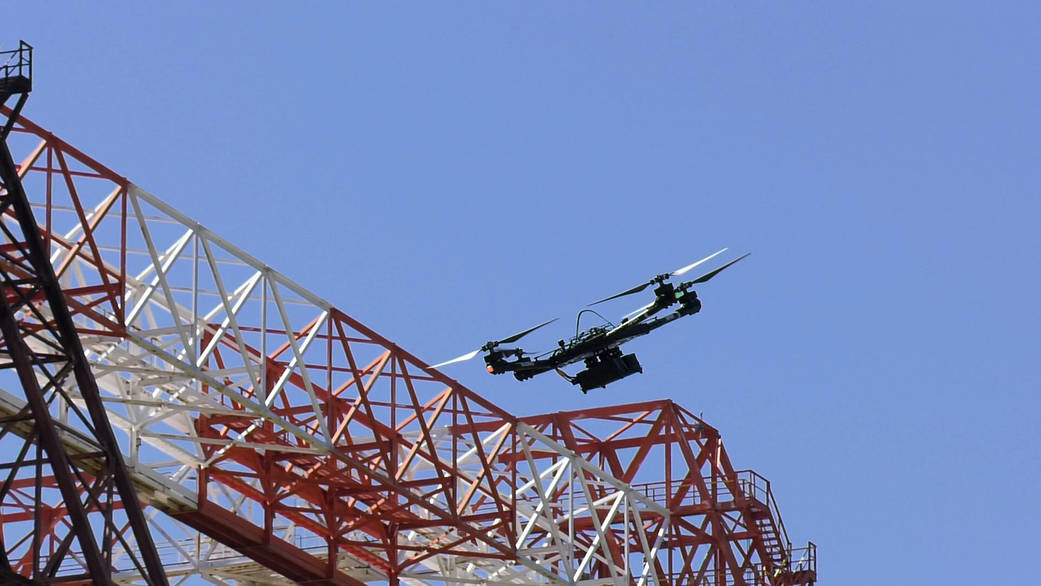 An Alta-X drone operated by NASA researchers flies over NASA Langley’s City Environment Range Testing for Autonomous Integrated Navigation (CERTAIN) as part of the Advanced Air Mobility project’s High Density Vertiplex (HDV) testing in April 2022.
An Alta-X drone operated by NASA researchers flies over NASA Langley’s City Environment Range Testing for Autonomous Integrated Navigation (CERTAIN) as part of the Advanced Air Mobility project’s High Density Vertiplex (HDV) testing in April 2022.
HDV is developing the necessary systems to enable urban drone flights that travel beyond visual sight.
Learn more
NASA Vertiport Research Takes Flight
Image Credit: NASA/Robert Lorkiewicz
Last Updated: Jul 21, 2022
Editor: Yvette Smith
Tags: Aeronautics, Image of the Day
https://www.nasa.gov/image-feature/its-certain
Jul 19, 2022
Apollo 11 Crew Trains for Excursion on the Sea of Tranquility
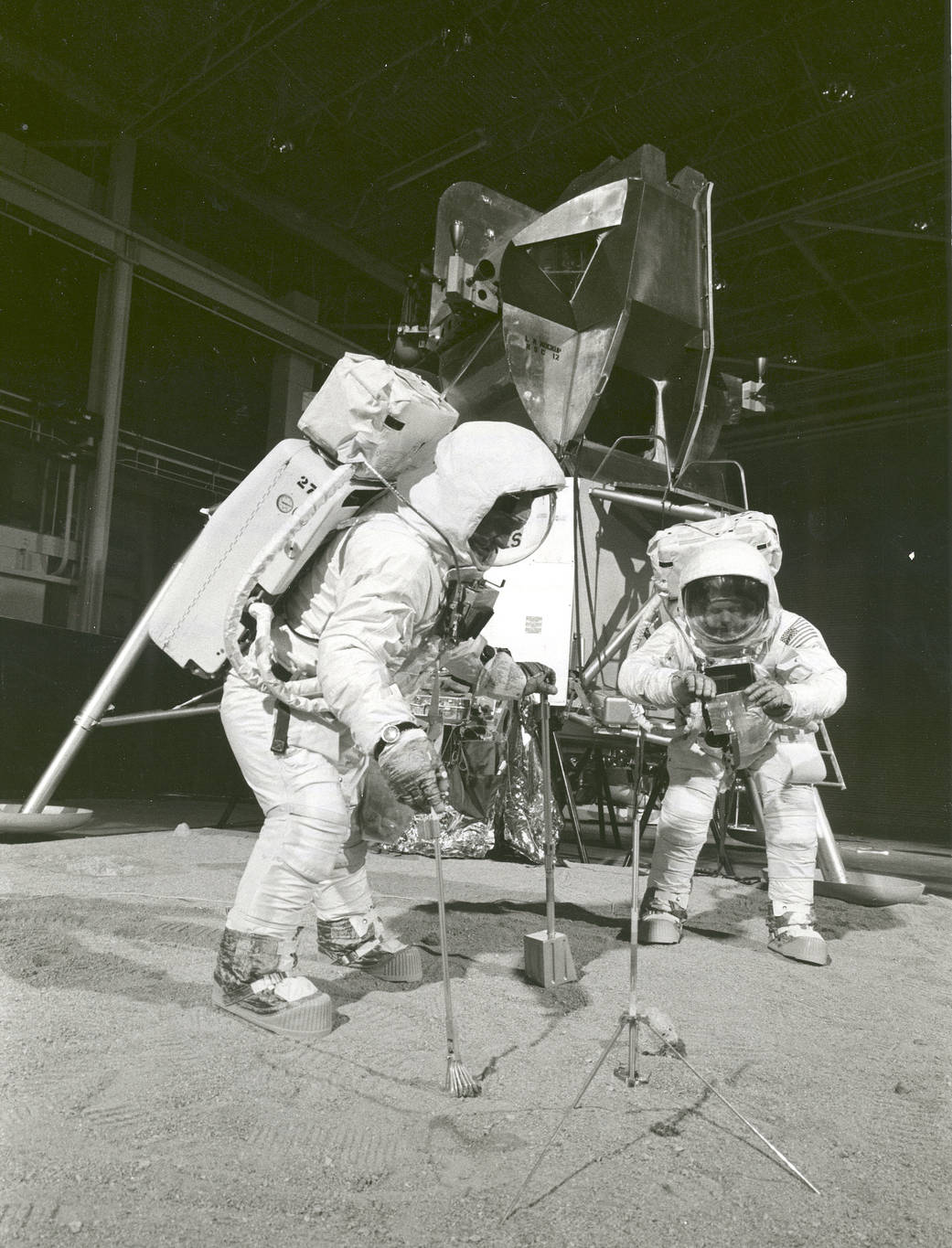
The Apollo 11 crew simulates deploying and using lunar tools on the surface of the Moon during a training exercise on April 22, 1969. Lunar module pilot Buzz Aldrin (left) uses a scoop and tongs to pick up a soil sample. Mission Commander Neil Armstrong holds a bag to receive the sample. In the background is a Lunar Module mockup.
On July 16, 1969, the crew off Apollo 11, including command module pilot Michael Collins, launched into history on a journey to explore Earth’s only natural satellite.
Landing on the Moon’s Mare Tranquillitatis, or Sea of Tranquility, on July 20, 1969, Armstrong and Aldrin became the first people to walk on another terrestrial body. At 5 p.m. EDT (21:00 UTC) on July 20, 2022, NASA TV will air restored footage of the Apollo 11 Moonwalk.
Learn More
Apollo 11 Mission Overview
Mission Image Gallery
Apollo 11 Videos
Smithsonian Air and Space Museum 3D visualization of Neil Armstrong’s suit, helmet, and gloves
Image Credit: NASA
Last Updated: Jul 20, 2022
Editor: Yvette Smith
Tags: Apollo 11, Image of the Day, NASA History
https://www.nasa.gov/image-feature/apollo-11-crew-trains-for-excursion-on-the-sea-of-tranquility
Jul 19, 2022
A Supernova’s Shockwaves
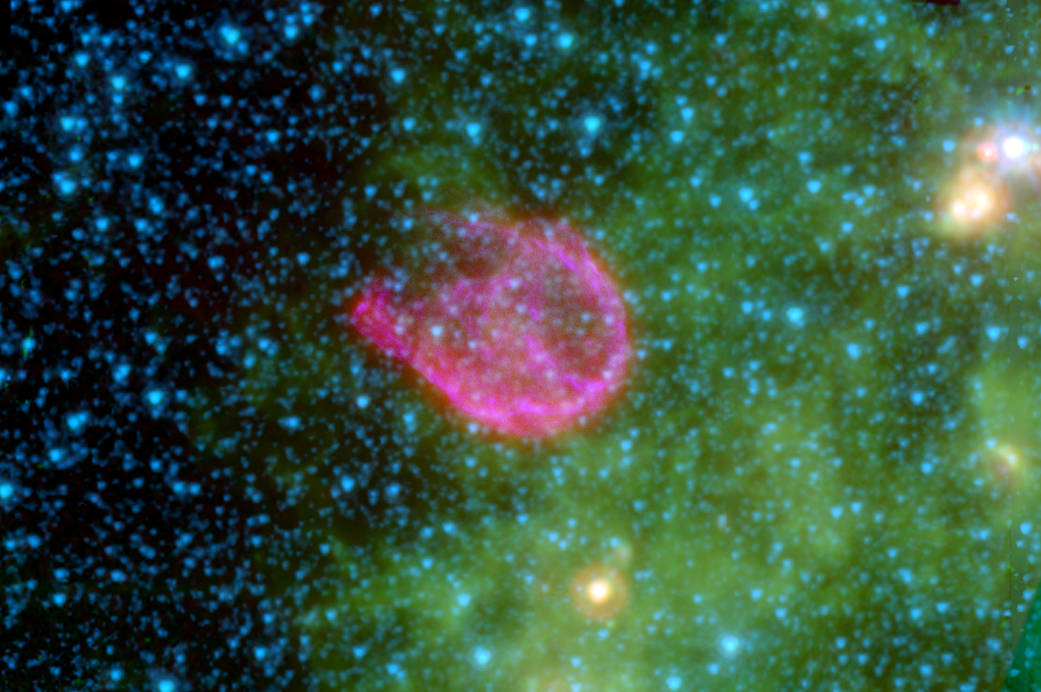
Supernovas are the explosive deaths of the universe’s most massive stars. In death, these objects blast powerful waves into the cosmos, destroying much of the dust surrounding them.
This 2007 composite from NASA’s Spitzer Space Telescope and Chandra X-ray Observatory shows the remnant of such an explosion, known as N132D, and the environment it is expanding into. In this image, infrared light at 4.5 microns is mapped to blue, 8.0 microns to green, and 24 microns to red. Meanwhile, broadband X-ray light is mapped purple. The remnant itself is seen as a wispy pink shell of gas at the center of this image. The pinkish color reveals an interaction between the explosion’s high-energy shockwaves (originally purple) and surrounding dust grains.
Outside of the central remnant, small organic molecules called polycyclic aromatic hydrocarbons, or PAHs, are shown as tints of green. Meanwhile, the blue dots represent stars within that lie along the line of sight between the observatories and N132D.
Image Credit: X-ray: NASA/SAO/CXC; Infrared: NASA/JPL-Caltech/A. Tappe & J. Rho
Last Updated: Jul 19, 2022
Editor: Yvette Smith
Tags: Image of the Day, Supernova
https://www.nasa.gov/image-feature/a-supernovas-shockwaves
Jul 18, 2022
A View from Above: Zero Gravity Facility Circa 1966

This tunnel view looking up from Level 5 is of the Zero Gravity Facility at Lewis Research Center, now known as John H. Glenn Research Center at Lewis Field, and was taken in Cleveland, Ohio, on Sept. 12, 1966. The tower dropped 460 feet and allowed scientists to perform 5.18 seconds of microgravity research. By comparison, the Washington Monument is 555 feet tall.
Image Credit: NASA
Last Updated: Jul 18, 2022
Editor: Yvette Smith
Tags: Image of the Day, Space Tech
https://www.nasa.gov/image-feature/a-view-from-above-zero-gravity-facility-circa-1966
Jul 15, 2022
SpaceX Dragon Heads to Station on 25th Resupply Mission

A SpaceX Falcon 9 rocket carrying the Dragon capsule soars upward after lifting off from Launch Complex 39A at NASA’s Kennedy Space Center in Florida on July 14, 2022, on the company’s 25th Commercial Resupply Services mission to the International Space Station. Liftoff was at 8:44 p.m. EDT.
Dragon will deliver more than 5,800 pounds of cargo, including a variety of scientific investigations, to the space station. The craft is expected to spend about a month attached to the orbiting outpost before it returns to Earth with research and return cargo, splashing down off the coast of Florida.
Image Credit: NASA/Kim Shiflett
Last Updated: Jul 15, 2022
Editor: Yvette Smith
Tags: Commercial Space, Image of the Day
https://www.nasa.gov/image-feature/spacex-dragon-heads-to-station-on-25th-resupply-mission
Jul 13, 2022
James Webb Space Telescope Senior Project Scientist John Mather
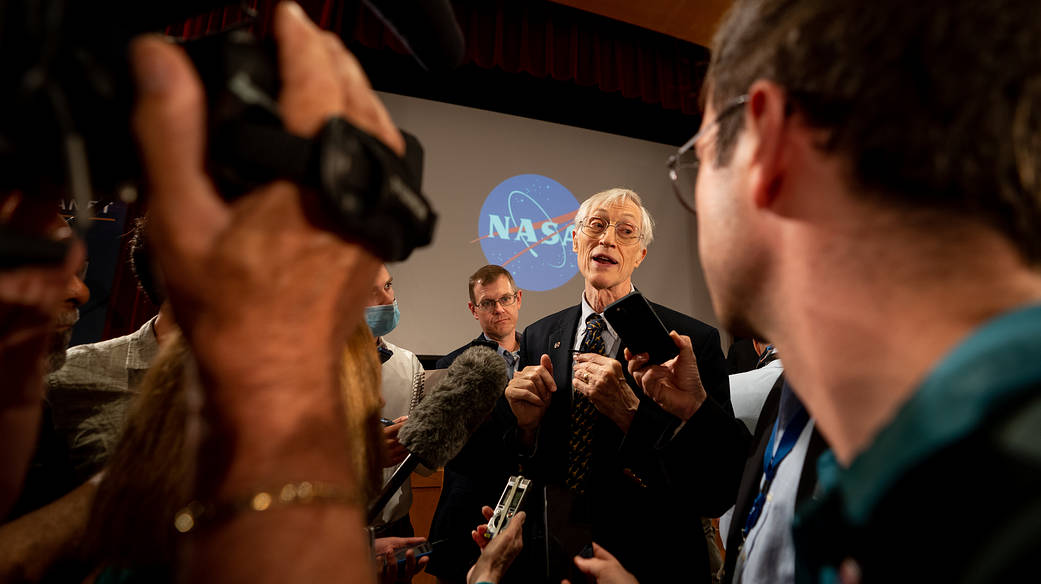
Senior Project Scientist John Mather, winner of the 2006 Nobel Prize for Physics, speaks with members of the media following the release of the first full-color images from NASA’s James Webb Space Telescope, Tuesday, July 12, 2022, at Goddard Space Flight Center in Greenbelt, Md. The first full-color images and spectroscopic data from the telescope, a partnership with European Space Agency and the Canadian Space Agency, are a demonstration of the power of Webb as the telescope begins its science mission to unfold the infrared universe.
Image Credit: NASA/Taylor Mickal
Last Updated: Jul 13, 2022
Editor: Yvette Smith
Tags: Image of the Day, James Webb Space Telescope
Jul 12, 2022
President Biden and the World Preview Webb Telescope’s First Image
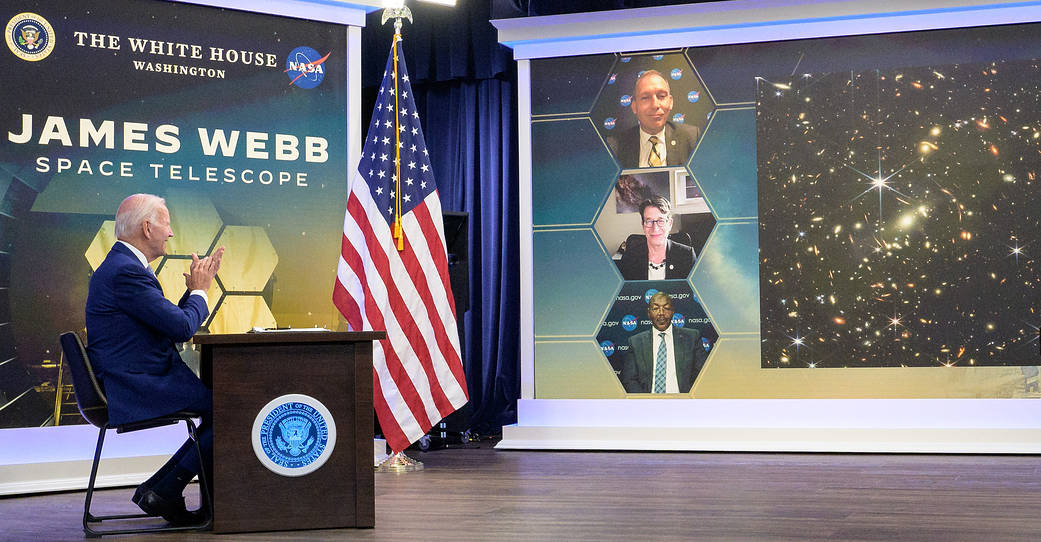
President Joe Biden previews the first full-color image from NASA’s James Webb Space Telescope, the highest-resolution image of the infrared universe in history, Monday, July 11, 2022, in Washington. On screen are NASA Associate Administrator for the Science Mission Directorate Thomas Zurbuchen, top, Deputy Director of the Space Telescope Science Institute (STScI) Nancy Levenson, and NASA James Webb Space Telescope Program Director Greg Robinson, bottom.
Learn more
First Images from the James Webb Space Telescope
Image Credit: NASA/Bill Ingalls
Last Updated: Jul 12, 2022
Editor: Yvette Smith
Tags: Image of the Day, James Webb Space Telescope
Jul 11, 2022
Behold: The Carina Nebula’s ‘Mystic Mountain’
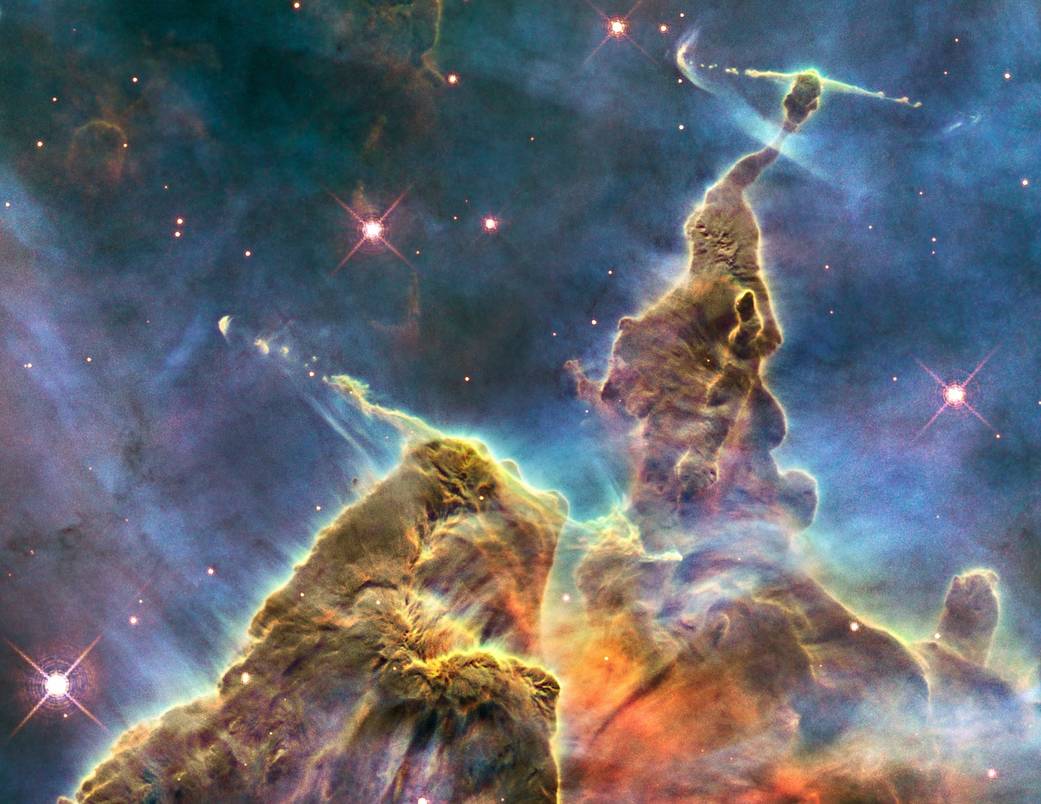 https://www.nasa.gov/image-feature/behold-the-carina-nebulas-mystic-mountain
https://www.nasa.gov/image-feature/behold-the-carina-nebulas-mystic-mountain
Within the tempestuous Carina Nebula lies “Mystic Mountain.” This three-light-year-tall cosmic pinnacle, imaged by the Hubble Space Telescope’s Wide Field Camera 3 in 2010, is made up primarily of dust and gas, and exhibits signs of intense star-forming activity. The colors in this composite image correspond to the glow of oxygen (blue), hydrogen and nitrogen (green) and sulfur (red).
NASA’s James Webb Space Telescope, a partnership with European Space Agency and Canadian Space Agency, will soon reveal unprecedented and detailed views of the universe, with the upcoming release of its first full-color images and spectroscopic data.
The Carina Nebula is one of a list of cosmic objects that Webb targeted for these first observations, which will be released in NASA’s live broadcast beginning at 10:30 a.m. EDT Tuesday, July 12. Each image will simultaneously be made available on social media as well as on the agency’s website.
Learn more:
NASA Shares List of Cosmic Targets for Webb Telescope’s First Images
Image Credit: NASA, ESA, M. Livio and the Hubble 20th Anniversary Team (STScI)
Last Updated: Jul 11, 2022
Editor: Yvette Smith
Tags: Image of the Day, Universe
Jul 9, 2022
Hubble Spots a Merging Galactic Gem
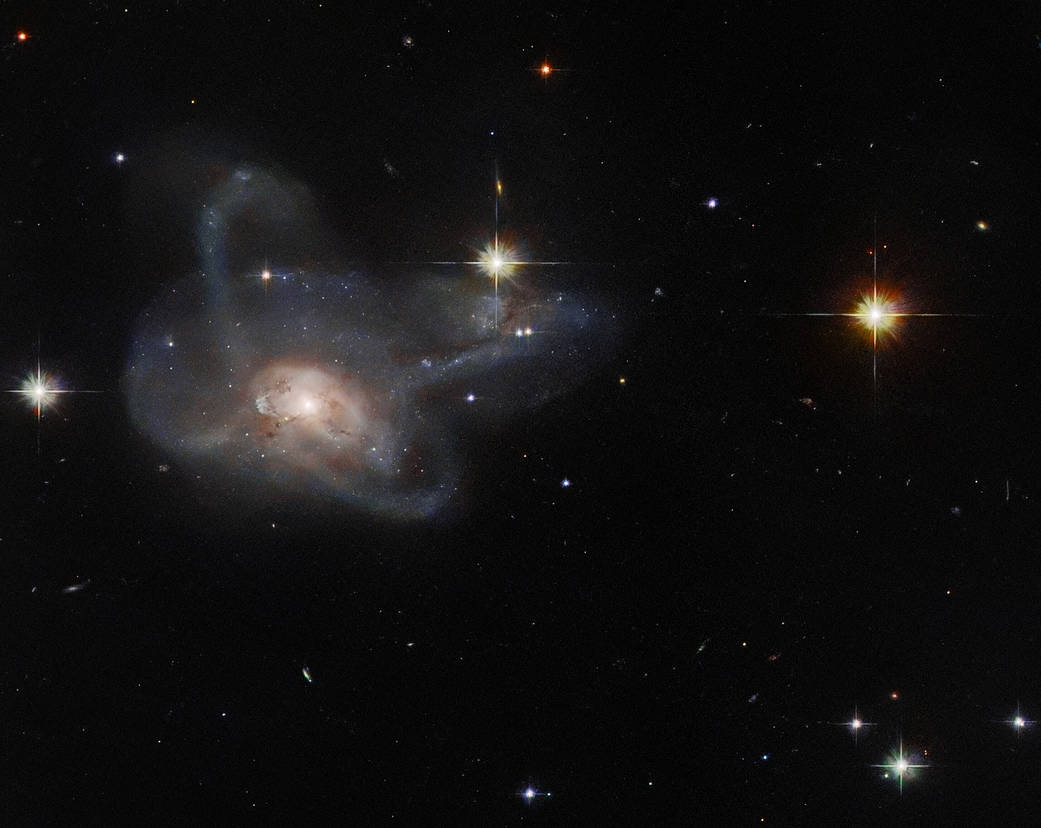 https://www.nasa.gov/image-feature/goddard/2022/hubble-spots-a-merging-galactic-gem
https://www.nasa.gov/image-feature/goddard/2022/hubble-spots-a-merging-galactic-gem
This NASA/ESA Hubble Space Telescope observation has captured the galaxy CGCG 396-2, an unusual multi-armed galaxy merger which lies around 520 million light-years from Earth in the constellation Orion.
This observation is a gem from the Galaxy Zoo project, a citizen science project involving hundreds of thousands of volunteers from around the world who classified galaxies to help scientists solve a problem of astronomical proportions: how to sort through the vast amounts of data generated by telescopes. A public vote selected the most astronomically intriguing objects for follow-up observations with Hubble. CGCG 396-2 is one such object, imaged here by Hubble’s Advanced Camera for Surveys.
Text credit: European Space Agency (ESA)
Image credit: ESA/Hubble & NASA, W. Keel
Media Contact:
Claire Andreoli
NASA’s Goddard Space Flight Center, Greenbelt, MD
301-286-1940
Last Updated: Jul 8, 2022
Editor: Andrea Gianopoulos
Tags: Galaxies, Goddard Space Flight Center, Hubble Space Telescope, Image of the Day, Universe
Jul 7, 2022
Countdown to the Webb Telescope’s First Images
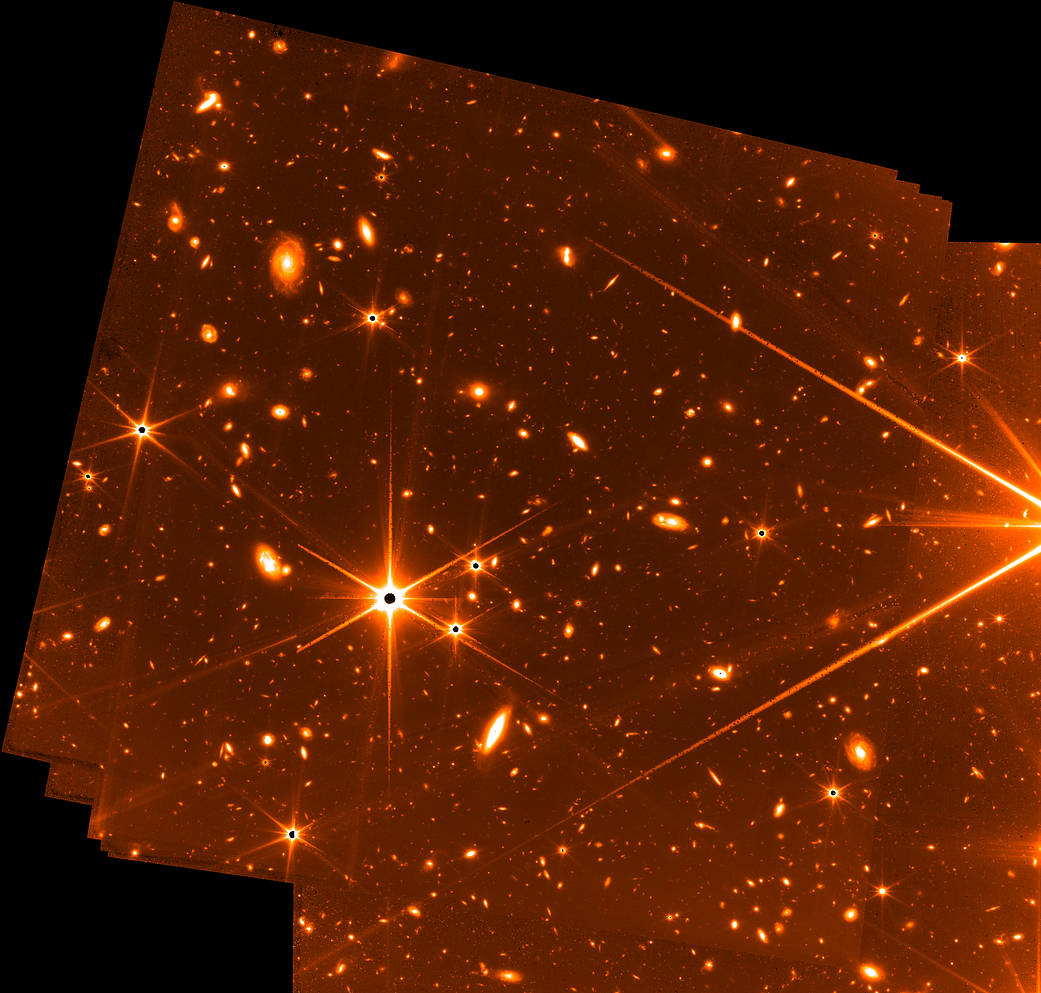 We’re less than one week away from the July 12, 2022, release of the first science-quality images from NASA’s James Webb Space Telescope, but how does the observatory find and lock onto its targets? Webb’s Fine Guidance Sensor (FGS), developed by the Canadian Space Agency, was designed with this particular question in mind. Recently it captured a view of stars and galaxies that provides a tantalizing glimpse at what the telescope’s science instruments will reveal in the coming weeks, months, and years.
We’re less than one week away from the July 12, 2022, release of the first science-quality images from NASA’s James Webb Space Telescope, but how does the observatory find and lock onto its targets? Webb’s Fine Guidance Sensor (FGS), developed by the Canadian Space Agency, was designed with this particular question in mind. Recently it captured a view of stars and galaxies that provides a tantalizing glimpse at what the telescope’s science instruments will reveal in the coming weeks, months, and years.
FGS has always been capable of capturing imagery, but its primary purpose is to enable accurate science measurements and imaging with precision pointing. When it does capture imagery, it is typically not kept: given the limited communications bandwidth between L2 and Earth, Webb only sends data from up to two science instruments at a time. But during the week-long stability test in May, it occurred to the team that they could keep the imagery that was being captured because there was available data transfer bandwidth.
The engineering test image – produced during a thermal stability test in mid-May – has some rough-around-the-edges qualities to it. It was not optimized to be a science observation, rather the data were taken to test how well the telescope could stay locked onto a target, but it does hint at the power of the telescope. It carries a few hallmarks of the views Webb has produced during its postlaunch preparations. Bright stars stand out with their six, long, sharply defined diffraction spikes – an effect due to Webb’s six-sided mirror segments. Beyond the stars – galaxies fill nearly the entire background.
The result – using 72 exposures over 32 hours – is among the deepest images of the universe ever taken, according to Webb scientists. When FGS’ aperture is open, it is not using color filters like the other science instruments – meaning it is impossible to study the age of the galaxies in this image with the rigor needed for scientific analysis. But: Even when capturing unplanned imagery during a test, FGS is capable of producing stunning views of the cosmos.
In this image, the FGS image was acquired in parallel with NIRCam imaging of the star HD147980 over a period of 8 days at the beginning of May. This image represents 32 hours of exposure time at several overlapping pointings of the Guider 2 channel. The observations were not optimized for detection of faint objects, but nevertheless the image captures extremely faint objects and is, for now, the deepest image of the infrared sky. The unfiltered wavelength response of the guider, from 0.6 to 5 micrometers, helps provide this extreme sensitivity. The image is mono-chromatic and is displayed in false color with white-yellow-orange-red representing the progression from brightest to dimmest. The bright star (at 9.3 magnitude) on the right hand edge is 2MASS 16235798+2826079. There are only a handful of stars in this image – distinguished by their diffraction spikes. The rest of the objects are thousands of faint galaxies, some in the nearby universe, but many, many more in the high redshift universe.
Learn More
James Webb Space Telescope blog
Join the Virtual Global Social for the Reveal of the James Webb Space Telescope’s First Images
Image Credit: NASA, CSA, and FGS team
Last Updated: Jul 7, 2022
Editor: Yvette Smith
Tags: Image of the Day, James Webb Space Telescope, Universe
Jul 6, 2022
Become a Jovian Vortex Hunter!
 A new NASA citizen science project, Jovian Vortex Hunter, seeks your help spotting vortices – spiral wind patterns – and other phenomena in photos of the planet Jupiter.
A new NASA citizen science project, Jovian Vortex Hunter, seeks your help spotting vortices – spiral wind patterns – and other phenomena in photos of the planet Jupiter.
Another NASA citizen science project, called Junocam, seeks help from members of the public processing images from NASA’s Juno Mission and choosing targets for the spacecraft. However, the new Jovian Vortex Hunter project provides images that have already been processed by the science team, making it quick and easy for anyone to lend a hand. Categorizing the images will help scientists understand the fluid dynamics and cloud chemistry on Jupiter, which create dazzling features like bands, spots and “brown barges.”
In this image from 2019, citizen scientist Kevin M. Gill created this image using data from the spacecraft’s JunoCam imager. This stunningly detailed look at a cyclonic storm in Jupiter’s atmosphere was taken during its 23rd close flyby of the planet (also referred to as “perijove 23”). Juno observed this vortex in a region of Jupiter called the “north north north north temperate belt,” or NNNNTB, one of the gas giant planet’s many persistent cloud bands. These bands are formed by the prevailing winds at different latitudes. The vortex seen here is roughly 1,200 miles (2,000 kilometers) wide.
Image Credit: NASA/JPL-Caltech/SwRI/MSSS/Kevin M. Gill
Last Updated: Jul 6, 2022
Editor: Yvette Smith
Tags: Image of the Day, Juno, Jupiter
Jul 5, 2022
Orbital Sunset Over Brazil

The last rays of an orbital sunset burst through Earth’s horizon as the International Space Station flew 258 miles above Brazil in this image from June 2022.
In 24 hours, the space station makes 16 orbits of Earth, traveling through 16 sunrises and sunsets. Want more station facts? Visit International Space Station Facts and Figures.
Image Credit: NASA
Last Updated: Jul 5, 2022
Editor: Yvette Smith
Tags: Humans in Space, Image of the Day
Jul 1, 2022
Making a Picture-Perfect Landing
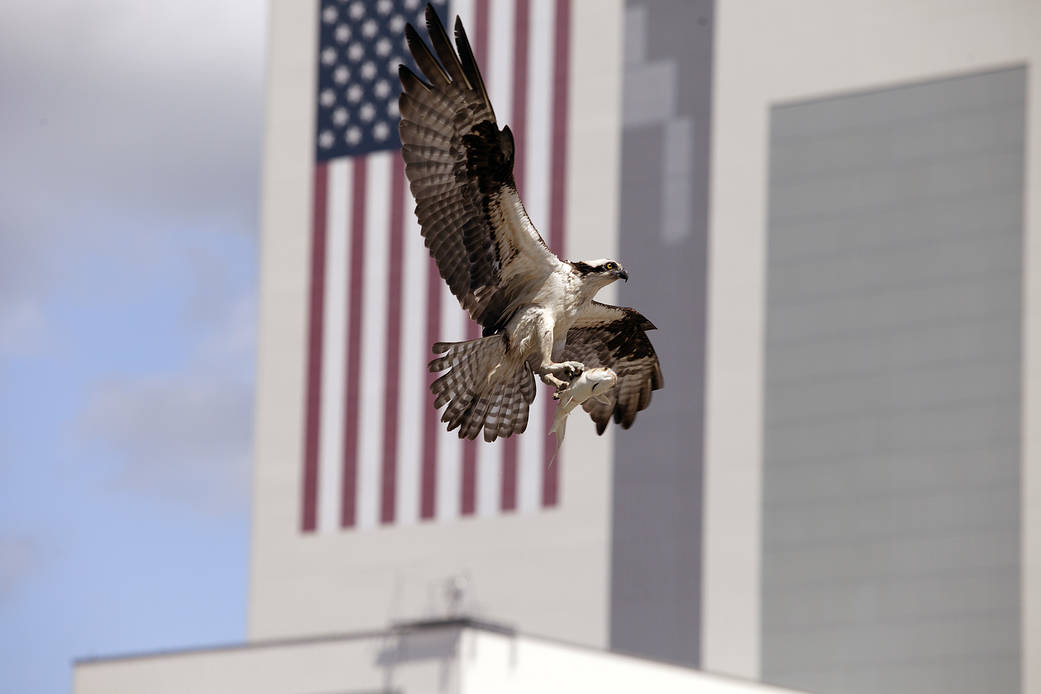 In this image from 2014, an adult osprey, carrying a fish in its talons, prepares to land in its nest atop a speaker platform in the press site parking lot at NASA’s Kennedy Space Center in Florida. In the background is the 209-foot-tall U.S. flag painted on the side of the 52-story Vehicle Assembly Building, which serves as the central hub of NASA’s premier multi-user spaceport, capable of hosting several different kinds of rockets and spacecraft at the same time. The parking lot borders the water of the Launch Complex 39 turn basin, making it an ideal source of food for the osprey. The undeveloped property on Kennedy Space Center is managed by the U.S. Fish and Wildlife Service through the Merritt Island National Wildlife Refuge. The refuge provides a habitat for a plethora of wildlife, including 330 species of birds. For information on the refuge, visit http://www.fws.gov/merrittisland/Index.html.
In this image from 2014, an adult osprey, carrying a fish in its talons, prepares to land in its nest atop a speaker platform in the press site parking lot at NASA’s Kennedy Space Center in Florida. In the background is the 209-foot-tall U.S. flag painted on the side of the 52-story Vehicle Assembly Building, which serves as the central hub of NASA’s premier multi-user spaceport, capable of hosting several different kinds of rockets and spacecraft at the same time. The parking lot borders the water of the Launch Complex 39 turn basin, making it an ideal source of food for the osprey. The undeveloped property on Kennedy Space Center is managed by the U.S. Fish and Wildlife Service through the Merritt Island National Wildlife Refuge. The refuge provides a habitat for a plethora of wildlife, including 330 species of birds. For information on the refuge, visit http://www.fws.gov/merrittisland/Index.html.
Image Credit: NASA/Daniel Casper
Last Updated: Jul 1, 2022
Editor: Yvette Smith
Tags: Image of the Day, NASA History
Jun 30, 2022
OMG: The Beauty of Ice
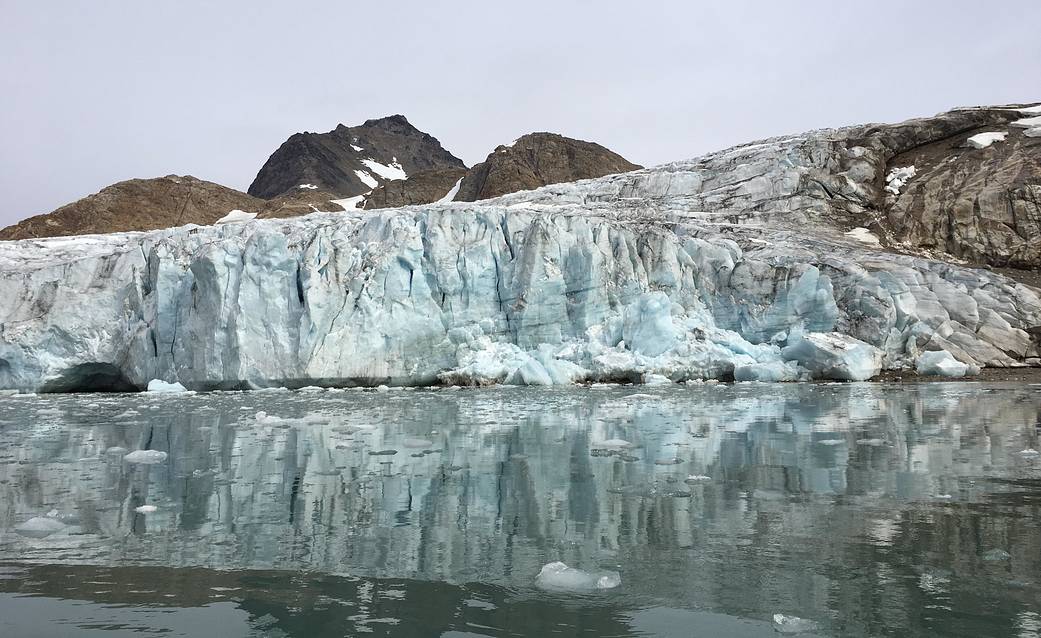 NASA’s Oceans Melting Greenland, or OMG, airborne mission found that most of Greenland’s glaciers that empty into the ocean are at greater risk of rapid ice loss than previously understood. OMG’s six-year field campaign studied the ocean’s role in glacial ice loss by gathering precise measurements of ocean depth, temperature, and salinity in front of more than 220 glaciers. The mission’s goal was to clarify our understanding of sea level rise over the next 50 years. This photo of Apusiaajik Glacier was taken near Kulusuk, Greenland, on Aug. 26, 2018, during OMG’s field operations.
NASA’s Oceans Melting Greenland, or OMG, airborne mission found that most of Greenland’s glaciers that empty into the ocean are at greater risk of rapid ice loss than previously understood. OMG’s six-year field campaign studied the ocean’s role in glacial ice loss by gathering precise measurements of ocean depth, temperature, and salinity in front of more than 220 glaciers. The mission’s goal was to clarify our understanding of sea level rise over the next 50 years. This photo of Apusiaajik Glacier was taken near Kulusuk, Greenland, on Aug. 26, 2018, during OMG’s field operations.
Image Credit: NASA/JPL-Caltech
Last Updated: Jun 30, 2022
Editor: Yvette Smith
Tags: Ice, Image of the Day
Jun 29, 2022
Turquoise Plumes in the Large Magellanic Cloud
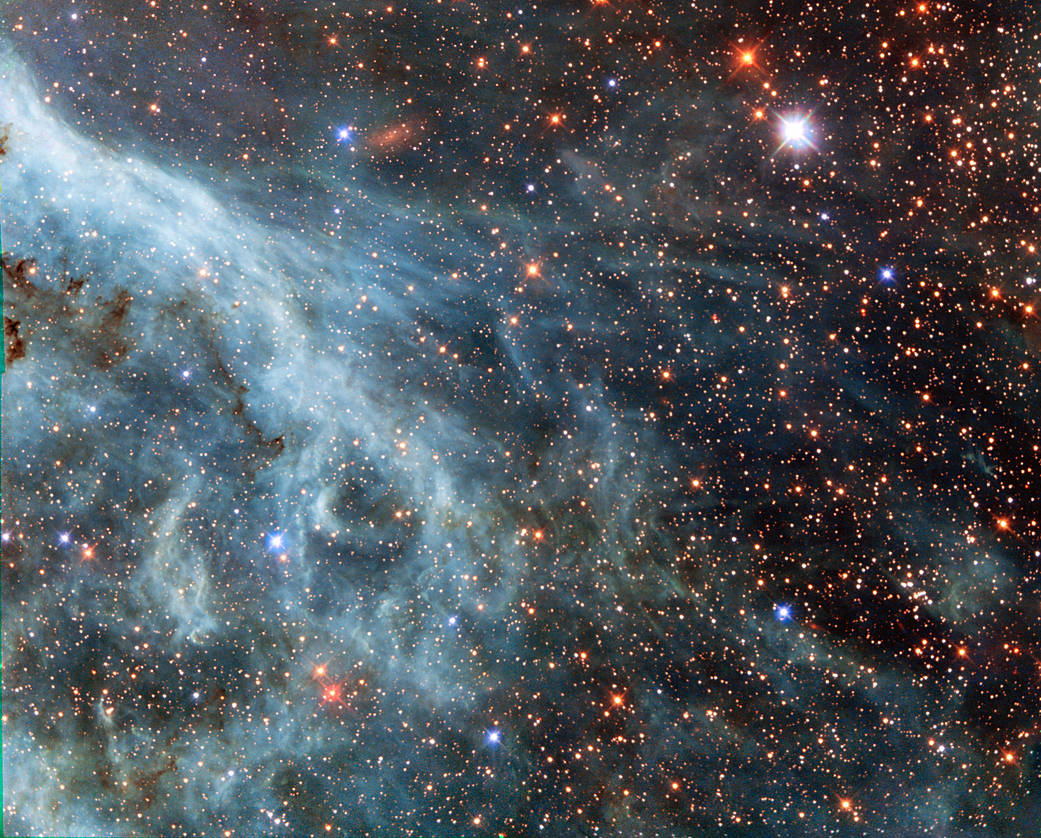
In this image from 2014, brightly glowing plumes of the Large Magellanic Cloud (LMC) appear almost like an ocean current with turquoise-tinted currents and nebulous strands reaching out into the surroundings.
This image shows part of the Tarantula Nebula’s outskirts located within the LMC, a small nearby galaxy that orbits the Milky Way and appears as a blurred blob in our skies. The Hubble Space Telescope has peeked many times into this galaxy, releasing stunning images of the whirling clouds of gas and sparkling stars.
In most images of the LMC the color is completely different to that seen here. For this image, researchers substituted the customary R filter, which selects the red light, and replaced it by a filter letting through the near-infrared light. In traditional images, the hydrogen gas appears pink because it shines most brightly in the red. Here however, other less prominent emission lines dominate in the blue and green filters.
This data is part of the Archival Pure Parallel Project (APPP), a project that gathered together and processed over 1,000 images taken using Hubble’s Wide Field Planetary Camera 2, obtained in parallel with other Hubble instruments. Much of the data in the project could be used to study a wide range of astronomical topics, including gravitational lensing and cosmic shear, exploring distant star-forming galaxies, supplementing observations in other wavelength ranges with optical data, and examining star populations from stellar heavyweights all the way down to solar-mass stars.
Image Credit: ESA/Hubble & NASA: acknowledgement: Josh Barrington
Last Updated: Jun 29, 2022
Editor: Yvette Smith
Tags: Image of the Day, Nebulae
Jun 27, 2022
Public Affairs Specialist Tyrone McCoy

“So often we hear that there’s this cycle of hurt, and hurt people hurt people, and if you came from something, you have to be a product of your environment.
“I do feel like, in a lot of ways, we are, whether you want to be or not. The people that raise you give you a bag, and they put things in it, and you carry those things with you, good or bad, for the rest of your life. But just because my dad struggled with addiction and just because my mom wasn’t always there didn’t mean that I had to be either of those things.
“I didn’t have an example, a great example, of what love looked like all the time, but I did, right? I didn’t have the Cosbys, but I had exactly what I needed to be who I needed to be. I think that part of my story is what I’d like to tell more of.
“Yeah, I came from brokenness, but I’m not broken.”
NASA Public Affairs Specialist, Tyrone McCoy, poses for a portrait, Tuesday, June 14, 2022, at the Mary W. Jackson NASA Headquarters building in Washington. Photo Credit: (NASA/Bill Ingalls)
“A piece of my story that I think needs to get told is that broken crayons still color.
“So often we hear that there’s this cycle of hurt, and hurt people hurt people, and if you came from something, you have to be a product of your environment.
“I do feel like, in a lot of ways, we are, whether you want to be or not. The people that raise you give you a bag, and they put things in it, and you carry those things with you, good or bad, for the rest of your life. But just because my dad struggled with addiction and just because my mom wasn’t always there didn’t mean that I had to be either of those things.
“I didn’t have an example, a great example, of what love looked like all the time, but I did, right? I didn’t have the Cosbys, but I had exactly what I needed to be who I needed to be. I think that part of my story is what I’d like to tell more of.
“Yeah, I came from brokenness, but I’m not broken.”
– Tyrone McCoy, Public Affairs Specialist, NASA Headquarters
Image Credit: NASA / Bill Ingalls
Interviewer: NASA / Tahira Allen
Check out some of our other Faces of NASA.
Last Updated: Jun 27, 2022
Editor: Tahira Allen
Tags: Image of the Day
Jun 24, 2022
CAPSTONE Slated for Launch Into Lunar Orbit
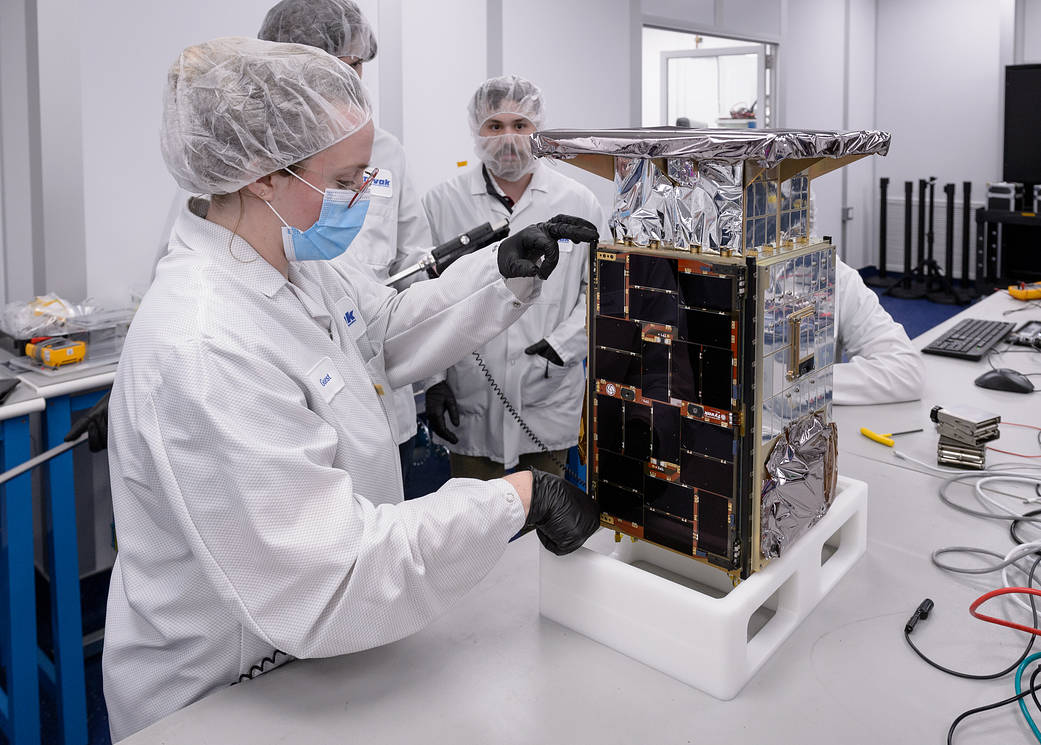
CAPSTONE, the pathfinder for NASA’s lunar outpost, will test an orbit around the Moon that has never been flown before.
In this image from April 2022, the Cislunar Autonomous Positioning System Technology Operations and Navigation Experiment, or CAPSTONE, was undergoing final construction – and with solar panel installation and vibration testing now complete, the small satellite was shipped to its launch location in New Zealand.
CAPSTONE is slated to launch on Monday, June 27, aboard a Rocket Lab Electron rocket from the company’s Launch Complex 1 in Mahia, New Zealand. Live coverage will begin at 5 a.m. EDT on NASA Television, the agency’s website, and the NASA app.
The destination for this microwave oven-size CubeSat is a near rectilinear halo orbit (NRHO). That same orbit is planned for Gateway, a multipurpose outpost for long-term lunar missions as part of the agency’s Artemis program.
Six days after launch, the Photon upper stage will release CAPSTONE into space for the first portion of the spacecraft’s solo flight. After a four-month journey to the Moon, CAPSTONE will test the dynamics of the NRHO for at least six months, helping reduce risk for future spacecraft. CAPSTONE will also demonstrate innovative spacecraft-to-spacecraft navigation technology and one-way ranging capabilities that could help future spacecraft fly near the Moon with reduced need for communication with Earth.
Image Credit: NASA/Dominic Hart
Last Updated: Jun 24, 2022
Editor: Yvette Smith
Tags: Earth’s Moon, Image of the Day
Jun 23, 2022
Mirrors Aligned: Webb Telescope’s First Full-Color Images Due in July
 After completing two additional mirror alignment steps in March 2022, the team confirmed the James Webb Space Telescope’s optical performance will be able to meet or exceed the science goals the observatory was built to achieve.
After completing two additional mirror alignment steps in March 2022, the team confirmed the James Webb Space Telescope’s optical performance will be able to meet or exceed the science goals the observatory was built to achieve.
This “selfie” was created using a specialized pupil imaging lens inside of Webb’s Near Infrared Camera, or NIRCam, instrument, which was designed to take images of the primary mirror segments instead of images of the sky. This configuration is not used during scientific operations and is used strictly for engineering and alignment purposes. In this image, all of Webb’s 18 primary mirror segments are shown collecting light from the same star in unison.
Now, we’re counting down to the release of the Webb Telescope’s first full-color images and spectroscopic data during a broadcast beginning at 10:30 a.m. EDT on Tuesday, July 12.
Learn more
NASA’s Webb Reaches Alignment Milestone, Optics Working Successfully
NASA Invites Media, Public to View Webb Telescope’s First Images
Image Credit: NASA/STScI
Last Updated: Jun 23, 2022
Editor: Yvette Smith
Tags: Image of the Day, James Webb Space Telescope
Jun 22, 2022
A Sea of Stars Like Sequins
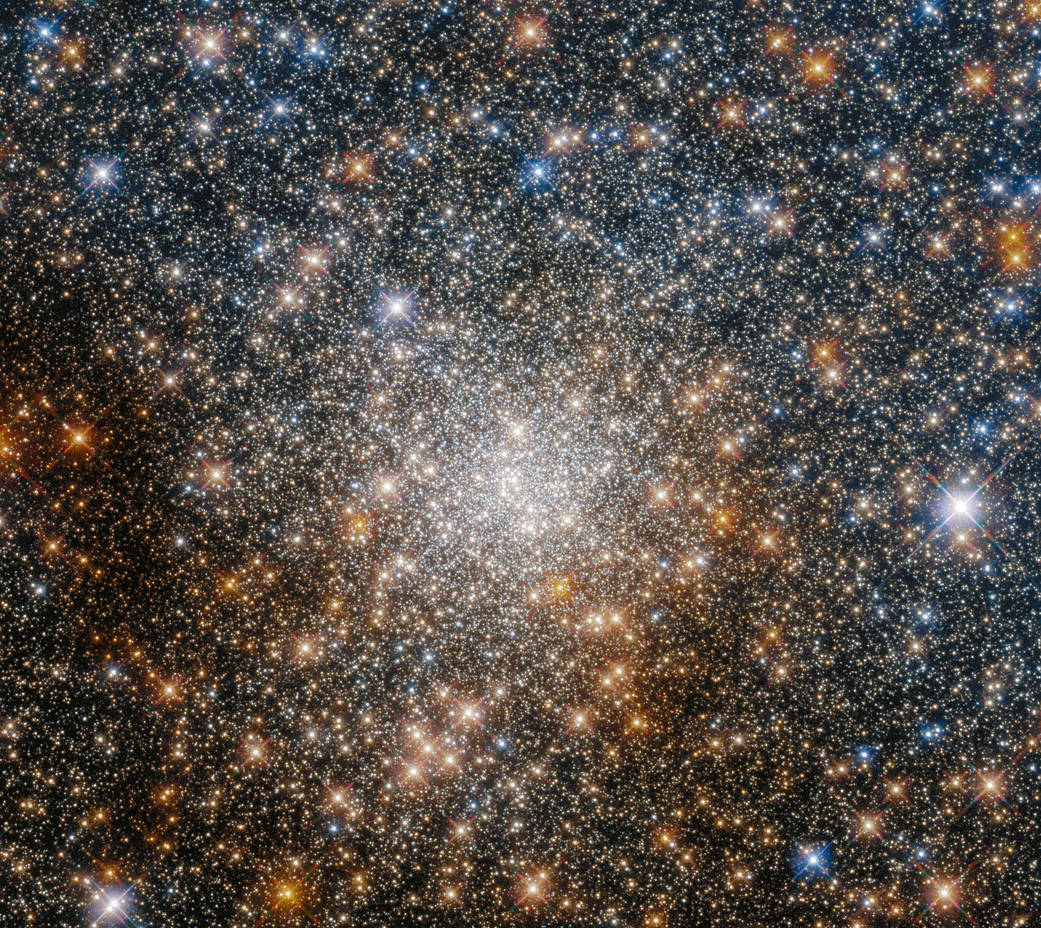
The Hubble Space Telescope captured this glittering scene using its Wide Field Camera 3 and Advanced Camera for Surveys.
Globular clusters are stable, tightly bound groups of tens of thousands to millions of stars. As this image demonstrates, the hearts of globular clusters are densely packed with stars. Terzan 9 is dotted with so many glittering stars that it resembles a sea of sequins.
This starry snapshot is from a Hubble program investigating globular clusters located toward the heart of the Milky Way, in which its central region holds a tightly packed group of stars known as the galactic bulge, an area rich in interstellar dust. This dust makes globular clusters near the galaxy’s center difficult to study, as it absorbs starlight and can even change the apparent colors of stars in these clusters. Hubble’s sensitivity at both visible and infrared wavelengths allows astronomers to measure how star colors change due to interstellar dust. Knowing a star’s true color and brightness allows astronomers to estimate its age, and thereby estimate the globular cluster’s age.
Image credit: ESA/Hubble & NASA, R. Cohen
Last Updated: Jun 22, 2022
Editor: Yvette Smith
Tags: Galaxies, Image of the Day
Jun 17, 2022
Galveston and the Beginning of Juneteenth
 The issue of General Order No. 3 by Union troops on June 19, 1865, marked the official end of slavery in Texas and the U.S.
The issue of General Order No. 3 by Union troops on June 19, 1865, marked the official end of slavery in Texas and the U.S.
On that Monday, enslaved African Americans in Texas learned of their freedom. That day of liberation became known as Juneteenth, when the Emancipation Proclamation was announced by Union troops in Galveston, Texas.
On Thursday, June 17, 2021, President Joe Biden signed into law legislation making Juneteenth a federal holiday.
NASA Administrator Bill Nelson said in this year’s Juneteenth Workforce Message:
“Last year, President Biden signed legislation into law that established June 19 as Juneteenth National Independence Day – a federal holiday. On this day, we reckon with the moral stain of slavery on our country. We reflect on centuries of racial injustice, inequality, and struggle that unfortunately still exist today.
“There is still more work to do, and it is work we must all do. I encourage all members of the NASA family to participate in a Juneteenth celebration and reflect on this historic event in our history. Let us reaffirm and rededicate ourselves to building a more perfect union.”
This image of Galveston and Bolivar Peninsula, separated by the Galveston Bay, were taken by the crew of the International Space Station as it orbited 262 miles above. In the image, Galveston Island is at right, Bolivar Peninsula at left, with the top of the picture being southeast.
Premiering on Juneteenth, Sunday, June 19, “The Color of Space” is a 50-minute inspirational documentary by NASA that tells the stories of Black Americans determined to reach the stars. It will be available to watch starting at noon EDT on NASA TV, the NASA app, NASA social media channels, and the agency’s website.
Image Credit: NASA
Last Updated: Jun 17, 2022
Editor: Yvette Smith
Tags: Image of the Day, NASA History
For more information, please visit the following link:
https://www.nasa.gov/multimedia/imagegallery/iotd.html
Go to the top
Leave a Reply